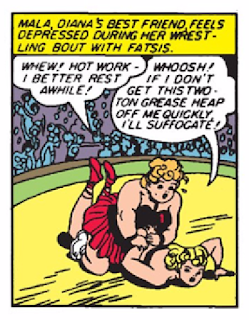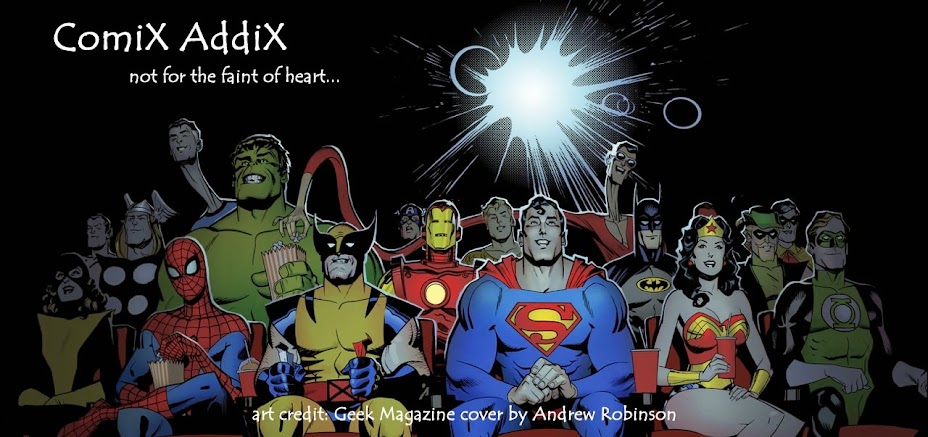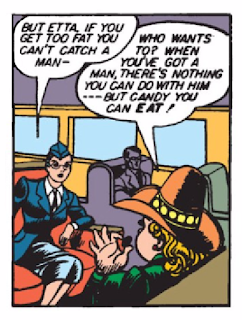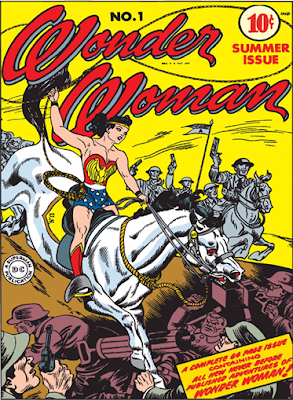Instead of falling in love with a comatose Steve Trevor (for no good reason), Now Wonder Woman not only gets the chance to interact with Steve before taking him back to the States, she actually builds the "healing ray" that brings him back to life!
Yup, that's right, this time Steve dies on the table from his injuries in the crash-landing. And Wonder Woman builds a device to bring him back from the dead.
Steve is a Zombie.

Most Amusing Panel Prize:
Not only can Wonder Woman pick up "brain waves" with her handy-dandy Amazon invention, she is also psychic/intuitive enough to know when those brain waves are coming.
-----------------------------------------------
I only own Sensation Comics #1 and All-Star Comics #8 (as far as early issues starring Wonder Woman go), so I'm not sure what may have transpired between those issues and Wonder Woman #1, but in this inaugural issue of her own mag, Marston and crew retell Wonder Woman's origin story making some not insignificant changes.
This time the war between women and men is writ large on the mythos of Ares' rivalry with Aphrodite. Where he would have men rule the earth through violence ("the sword"), Aphrodite would have women "conquer men with love."
UGH. Gender norms, anyone?
This presumed ongoing animosity between the genders is illustrated with a lengthier version of the Hercules myth in which he steals Hippolyta's magical girdle by seducing her or, as Marston puts it, using "woman's own weapon" against her.
More UGH.
Hearkening back to Gilbert & Gubar's analysis of the Goddess and Whore dichotomy, Diana is firmly fixed in the goddess category. She is ultra-feminine (to the 1940's standards for white Western women) and completely selfless. She is purity itself in motive and deed.
 Unfortunately, these traditional feminine beauty standards are actually reinforced by the Amazons through the mocking of their larger sisters. In the competition for who will take Steve Trevor back to America, Diana's best friend, Mala, wrestles with Fatsis (Fat-sis, seriously?), mocking her about her weight.
Unfortunately, these traditional feminine beauty standards are actually reinforced by the Amazons through the mocking of their larger sisters. In the competition for who will take Steve Trevor back to America, Diana's best friend, Mala, wrestles with Fatsis (Fat-sis, seriously?), mocking her about her weight.Even Diana badgers Etta Candy into trying to lose weight so that she can "catch a man." When Etta argues with the "man motive," suggesting men find her attractive as she is (otherwise, she would "knock 'em for a loop"), Diana shifts tack to suggest Etta will feel better if she loses weight, but then Diana has to go and try to guilt her by suggesting Etta's being "unpatriotic to hoard...fat."
So, in addition to these antiquated notions of what makes women desirable/beautiful, there's some downright racist imagery of Black, Asian, and Hispanic characters in this issue. Yeah, yeah, a product of the time in which these stories were written... but, dang. They are truly awful (and so incongruous with the equality the mag ostensibly promotes through its American patriotism during WWII).
Final Notions:
 There's a lot to like about this Diana Prince. She tries to rescue, not just defeat. (When Pepita, the villain in the last story in this issue, is endangered by a raging bull, Wonder Woman saves her and encourages her to reform despite all Pepita has done through her villainy.)
There's a lot to like about this Diana Prince. She tries to rescue, not just defeat. (When Pepita, the villain in the last story in this issue, is endangered by a raging bull, Wonder Woman saves her and encourages her to reform despite all Pepita has done through her villainy.)But these early efforts at a feminist icon stumble along unconscious assumptions about gender (it's more complicated than boy/girl) and beauty (there's more than one body type) and race (just UGH).
(And Steve is still as interesting as a cardboard cut-out. Cardboard Zombie Steve. Diana fell in love with that?)
Series: Wonder Woman (1942)
Issue #: 001
Copyright: DC Comics
Cover Date: Summer 1942
Cover Price: 10¢
Page Count: 57 pages
Print Release: 22-April-1942
Digital Release: 25-June-2011
Writer:
|
William Moulton Marston (as Charles Moulton)
|
|
Penciler:
|
||
Inker:
|
||
Colorist:
|
None Listed
|
|
Cover Art:
|
||
Source Links:
|
||
Story Titles:
|
“The Origin of
Wonder Woman”; “Wonder Woman Goes to the Circus”; “The Master Plan of Paula
Von Gunther”; “The Greatest Feat of Daring in Human History”
|
|










No comments:
Post a Comment